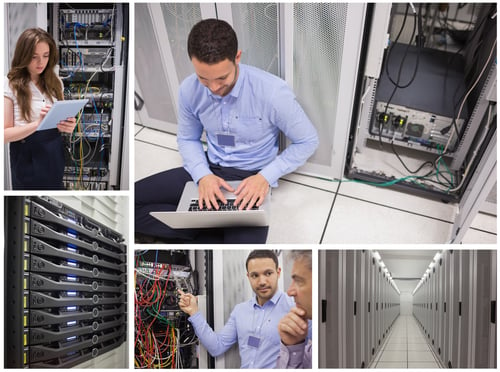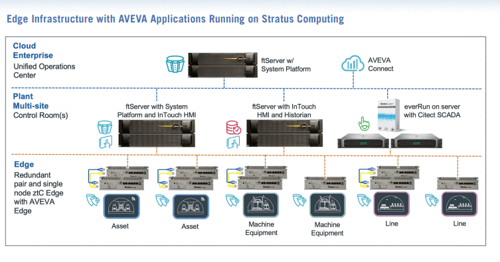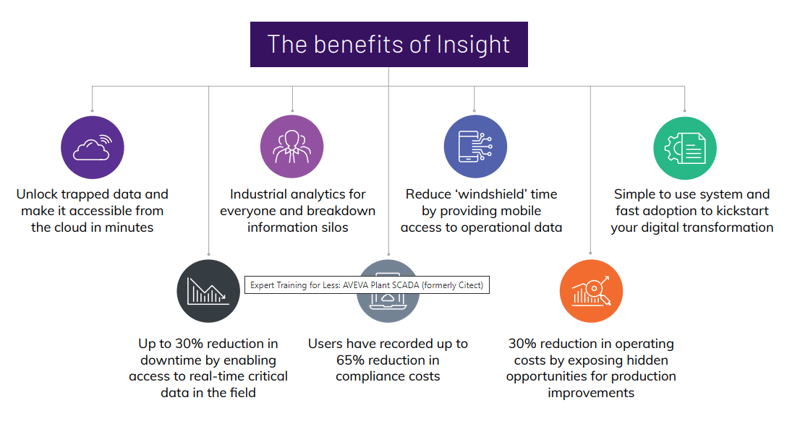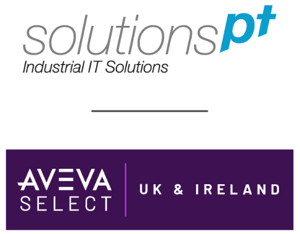IIoT and Cloud Solutions - by SolutionsPT
The Industrial Internet of Things (IIoT) is a methodology, a practice, an implementation sweeping through businesses and industries worldwide. On a basic level, IIoT is a way of congregating data that was previously inaccessible and locked within inflexible data streams. This provides all stakeholders with a more complete and comprehensive view of operations.
Imagine smart TVs and watches or security cameras - devices that were historically lacking in internet connection but now have that capability. This is IoT, the Internet of Things. IIoT is used to refer to industrial equipment and plant assets that are now integrated.
Developments in technology are ushering in the age of Industry 4.0, where real-time data is captured and made available within integrated digital ecosystems. Similarly, software is now increasingly platform-agnostic, this means that plant floor information won't be originating from a single platform, but there will be a multitude of systems that needs to feed into a company's digital nervous system.
01 IIoT is Key for Business
The original industrial revolution brought steam-powered automation to manufacturing. IIoT is changing traditional thinking and models, optimising plant processes previously not thought possible and even helping to build smart cities. It will redefine the markets for key players who are willing to digitally transform their business. For businesses, IIoT implementations amplify the power and usefulness of data.
IIoT affects every industry and organisations realise it has developed beyond the ‘trend’, now actively restructuring global markets and economic models. As businesses stand to gain the ability to optimise and reduce operational costs and energy consumption, as well as manage maintenance (amongst other things), they’re left with one question: How do you implement IIoT?
Market analysts propose IoT will connect 46.1 billion devices by 2025, generating 79.4 zettabytes of data. Within our interconnected marketplaces, lack of access to integration is a death knell for business growth. Without digitisation, there can be no transformation.
Empowering Your Workforce
IIoT isn’t just the means for industry to improve and optimise its processes. It also works to empower your workforce by providing the right data and the right visibility - all at the right time. It’s a way of delivering the fourth industrial revolution for all stakeholders, aligning people and processes into proactive, coherent systems.
An organisation relies on its workforce. So if you neglect to empower that workforce with the right applications, you could restrict the capabilities of a critical element in business productivity and success.
The modern workforce expects a higher level of interaction with plant equipment and other company assets, even extending towards the need for a cloud-based ecosystem detailing everything from overall efficiency to the granular data. This means access to the system anywhere, whether an employee finds themselves on the shop floor or even at home.
Architecture for All
Business processes need to keep an employee engaged. So, if your processes or workflows are difficult to understand or inaccessible, this will hinder progress. This applies to any level of worker, from shop floor staff to CEOs. An architectural structure must respond to the needs of all.
When implementing IIoT systems, consider how they can enhance your current processes rather than completely changing them. Any progress needs to help, not cause disruption. For example, how do your employees regularly access plant information? A question like this will lead you to think about how an IIoT interface can be created for universal accessibility.
Employees want timely business intelligence. Fortunately, the right IIoT implementations guarantee this, making it easier to aggregate, standardise and deliver data to all parties.
Guaranteeing Employee Engagement

IIoT implementations help to keep employees engaged. They distribute process development opportunities for the non-programmer or the non-manager, as greater visibility grants access to issues which could have been hiding under the surface of siloed data streams.
Previously, resourcefulness in a workforce was limited by the lengths that data could go to. Siloed, non-timely data doesn’t go that far in the business world, but with IIoT, employee engagement is easy to provide.
Gaining The Value of IIoT
What does an IIoT-optimised system bring to the table?
Enhanced Flexibility Within System Architecture
Collect data within the edge to enterprise business level, then provide context to that data through optimised analytics in the cloud. IIoT is inherently platform-agnostic, meaning the entire supply chain can be brought together within the architecture of your choosing.

Improved Data Context
When real-time data is collected in the cloud for enhanced visibility and analytics functions, you benefit from a single source of truth - one that’s inherently trustworthy. This data is accessible company-wide, meaning teams can easily find the data and context they need.
Determine True ROI
With siloed, non-integrated business technology, calculating ROI is a hard thing to determine. IIoT provides the solution for this, aggregating data into streamlined packages so that it’s in the perfect place to be analysed.
Similarly, through any artificial intelligence (AI) or machine learning (ML) capabilities, you can monitor the performance of your assets and undertake any predictive maintenance.
Improved Decision-Making
When we combine the previous value points of IIoT, we gain an environment that actively promotes smarter decision-making. The mixture of AI, ML, cloud analytics and data accessibility is the foundation for business decisions you can make with confidence and assuredness.
02 Cloud Computing
Experience the next level of business-critical computing in the cloud.
Digital transformation is all around us and nowhere is it found more than in cloud computing technologies. Digitising asset and operational lifecycles are becoming ever more business-critical.
Businesses need assets such as servers and databases, software and analytics, intelligence and processing power - all things delivered by the cloud via the internet. The cloud consolidates and aggregates data from multiple sources, presenting it on the platform of your choice with the context you’re looking for.
The cloud is platform-agnostic, meaning it can be accessed through the multiple device types that supplement an engaged workforce.
What Does Cloud Computing Deliver for Businesses?
Why are businesses now choosing to use the cloud? Because it represents an investment in time-saving, collaborative software that can help to reduce costs and better connect the internal functions of a business. Cloud computing is a crucial part of the IIoT experience. Let’s explore what the cloud delivers for modern businesses.
Futureproof Any Investments
We mentioned previously how IIoT doesn’t have to be a complete disruption to your current systems, but rather an implementation to enhance, not replace. Cloud computing means Edge and IIoT devices are connected, benefitting from capabilities such as advanced analytics and ML.
Cloud computing is the digital ‘twin’ of your physical assets, providing holistic analytic functions that reduce risk with future investments.
Promote and Improve Collaboration
When data is held within one easily-accessed place, transparency and visibility are improved. For example, the AVEVA Connect platform provides a unified view of plant operations, from engineering to intelligence. This means your employees are better prepared to collaborate as they all have access to the same data ecosystem.
This kind of visibility isn’t just reserved for employees but partners, suppliers and other key stakeholders can also gain access. Sharing engineering models or operational information is simple and comes contextualised. The cloud is essentially the place for improved collaboration and efficiency.
Reduce Your Costs
Use of the cloud doesn’t require the additional overheads of installation or deployment. There’s no need to invest in update packages or costly training workshops. Similarly, due to the nature of the cloud and the fact it’s a system-agnostic implementation, it’s a commercially flexible option.
Use cases can be paid for through many avenues and scaled to your needs, meaning you can ‘shop around’ for the right choice for both your needs and budget.
An Example of a Cloud Solution
Exploring cloud capabilities with AVEVA Edge.
If you’re looking for a full-features HMI for both embedded and OEM applications, then AVEVA Edge is a wise choice. This application finds itself at home in the most unique automation environments, representing unparalleled ease-of-use and cost-effectiveness. It also stands out because of its integrated cloud environment, granting unprecedented machine functionality, remote configuration and inter-device operability.
AVEVA Edge utilises the cloud to distribute, scale and integrate applications. With its in-built agnostic HMI and SCADA capabilities, this software integration can be accessed over multiple devices, such as industrial computers, tablets and even smartphones.
This is offered through the AVEVA Connect Edge Management Portal, which enables remote deployment of AVEVA Edge applications via the cloud. It’s a scalable and flexible solution that connects your asset and operations value chains, improving overall profitability. It also offers cloud-based training opportunities for both onboarding and upskilling.
Cloud Benefits
Cloud computing is a scalable solution, adapting to changing user-based demands. It offers increased accessibility and collaboration with information shared between all parties quickly and efficiently - anytime, any place.
Flexible Pricing
Pricing is determined by both application and usage.
User-Friendly
Not a complete change to your processes, just a new way to access them.
Improved Availability
The cloud provider manages disaster recovery and grants high availability.
Better Ownership Costs
With constant updates of the latest versions and limited maintenance needed for cloud solutions, you can experience healthier overheads.
.jpg?width=1000&name=pasted%20image%200%20(1).jpg)
03 Artificial Intelligence
Empowering workforces through artificial intelligence.
AI implementations are IIoT solutions that work to improve industrial processes across the board. With the right AI solution, you’ll find that decision-making is undertaken with great scope for cost-saving and operational sustainability.
AI is changing the way we work. From enhancing design and process engineering to forecasting for operations, the implementation of AI is mitigating business risk and improving both safety and efficiency.
Within industrial settings, AI is most commonly used in the form of a ‘digital twin’ which is a virtual, software-based representation of the physical set-up of the plant or manufacturing floor. It can also stretch further in its representation, becoming integrated with buildings, full factories and even cities ( known as ‘smart cities’).
AI is constructed from a multitude of applications, from IoT/IIoT to computer systems and analytics, working in tandem to model and forecast physical assets and environments. In addition to that, AI helps to bridge the gaps between an ageing workforce and new, non-qualified staff, acting as an intermediary and secondary learning/training apparatus.
Within engineering, some AI can generate automated designs, ensuring a lower operational cost and even lower risk within your business-critical projects. In the case of the digital twin, AI analyses your industrial environment and can recommend points for improvement, enhancing operations while retaining compliance with regulatory standards.
Cylance: An Example of AI
The Cylance platform is an AI-driven cybersecurity suite. It works to protect the complete attack surface with threat detection, automated threat prevention and response capabilities.
With its unique AI approach, Cylance can predict and protect against known and unknown threats, with a predictive advantage against unknown malware. It has a protection value that works at an average of 25 months before a specific malware appears online.
Gone is the need for continual signature updates because mathematical algorithms are being used for malware detection. Within an OT environment where the time windows for patching and maintenance are small, this is the perfect set up.
It’s also the right cybersecurity platform for defence against file-less attacks and zero-day payload execution. Currently, it’s deployed to more than 3,400 organisations securing 14.5 million endpoints.
The Four P’s of AI
Within the industrial context, AI can be compartmentalised into the ‘four P’s’:
Performance
Performance covers the areas in which ML combines with first principle analysis to improve both efficiency and yield. AI provides advanced modelling techniques which are then supported by algorithms created specifically for both industry and asset. Through this, resolution times are accelerated by quickly identifying asset and process issues.
Predictive
Powered by ML, you can utilise advanced pattern recognition to identify any anomalies within your industrial processes. Detect issues such as equipment failure, workflow inefficiencies and engineering problems.
Prognostic
Prognostic details the ability to accurately forecast future events and operational scenarios. Through prognostic capabilities, you can manage any potential risks and improve operational sustainability and consistency. Prognostic AI functions are driven by deep-learning, neural networks and reinforcement learning - they all help to provide insight on those areas in need of improvement.
Prescriptive
Prescriptive functions helped to increase efficiency within decision making. Through optimised solutions, risk-based decision support and root cause analysis, you can effectively determine the right choices to make, ensuring success over the entire arc of a project.
04 Augmented Reality
Digital enhancing our interactions with the real world.
Augmented Reality (AR) is an interactive experience where data expressed in the virtual world is married with that of the real world through modern technology. Within industrial settings, it can be used to empower workforces, supporting their training and giving them better avenues for creativity and design.
A good example is the AVEVA Extended Reality (XR) software. It’s an XR/AR implementation that can optimise the following processes:
- Operations and maintenance.
- Workforce upskilling.
- Design review and commissioning.
AVEVA XR is a way of driving new and improved workforce efficiency, achieving better decisions and enhanced execution of work.
Benefits of AVEVA XR
AVEVA XR gives human operators effortless interaction capabilities with all digital twins that exist within an industrial setting, giving you unparalleled ability to collaborate, visualise, interact and connect.
Collaborate
AVEVA XR enables a connected experience so teams and individuals across the globe can access and collaborate on designs and problem-solving.
Visualise
Contextualised data and information can be overlaid on the real or virtual world, through 3D, AR, Mixed Reality (MR) and Virtual Reality (VR).
Interact
With the human-machine interface, operators can interact seamlessly with the digital twin.
Connect
A digital twin can be easily connected with any data source within an asset or operational lifecycle.
What Can XR Accomplish?
AVEVA XR excels in supporting three key areas:
Operations and Maintenance
Through XR, a digital twin is visualised, providing digitised maintenance capabilities while connected to real-time data sources. This helps to prevent downtime and failures with both being costly issues to avoid.
Workforce Upselling
There can be issues bridging the gap between ageing workforces and upskilling both junior and new team members. AVEVA XR provides training for operators, maintenance and HSE personnel, as well as engineers. The training time can be lowered from years to months. Digital twins of assets provide training modules that don’t affect real processes if altered incorrectly, saving you money.
Design Review & Commissioning
Design review is a crucial assessment in any capital project engineering process. With AVEVA XR, you can reduce the time, cost and risk associated with these processes. Enter a 3D plant model to gain full visibility and understanding of ergonomic engineering design within a collaborative VR experience.
Copyright © 2026 All Rights Reserved by SolutionsPT.



